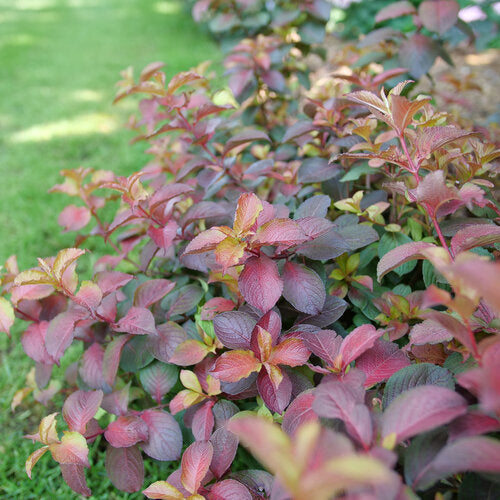Riverdene Garden Center
Midnight Sun Weigela (Proven Winners)
Midnight Sun Weigela (Proven Winners)
Couldn't load pickup availability
Weigela florida ‘Verweig9’ Midnight Sun®
Midnight Sun Weigela is a compact, low-growing deciduous shrub known for its stunning, multicolored foliage that changes from golden-yellow to orange and red throughout the season. Unlike traditional weigelas, this variety is grown for its foliage rather than its flowers. It is cold-hardy (Zone 4-8), drought-tolerant, and easy to maintain, making it a great choice for borders, foundation plantings, and mixed gardens in Southwest Saskatchewan.
Planting & Location
- Hardiness Zone: 4-8 (borderline hardy for Zone 3—winter protection recommended in exposed areas)
- Mature Size: 12-18 inches tall, 18-24 inches wide
- Growth Rate: Slow to moderate
- Sunlight Needs: Full sun to partial shade (best color in 6+ hours of direct sun)
-
Soil Preference:
- Prefers well-drained, loamy soil.
- Tolerates clay, sandy, and slightly alkaline soils.
- Avoid soggy or poorly drained areas—weigelas dislike wet feet.
- Spacing: 18-24 inches apart for mass planting, 2+ feet apart for individual shrubs.
Watering
- Young Plants (First Year): Water deeply 1-2 times per week to establish roots.
- Established Plants: Drought-tolerant; water every 2-3 weeks in dry conditions.
- Avoid Overwatering: Prefers moderate soil moisture, but avoid excessive watering.
Fertilizing
- First Year: No fertilizer needed—focus on root development.
-
Mature Plants:
- Apply a balanced slow-release fertilizer (e.g., 10-10-10) in early spring if growth is slow.
- Organic alternative: Compost or well-rotted manure in spring.
Pruning & Maintenance
- Best Time to Prune: Late winter to early spring, before new growth begins.
-
How to Prune:
- Minimal pruning required—naturally maintains a compact, mounded shape.
- Remove dead or damaged branches to encourage fresh growth.
- Since this variety is grown for foliage, pruning is not necessary for flowering purposes.
Pest & Disease Management
Highly resistant to pests and diseases, but minor issues can occur.
Common Pests:
-
Aphids – May cause leaf curling and sticky honeydew.
- Solution: Spray with insecticidal soap or introduce ladybugs.
-
Spider Mites – Cause yellowing leaves in dry conditions.
- Solution: Hose off with water or use insecticidal soap.
Common Diseases:
-
Powdery Mildew – White fungal growth on leaves.
- Solution: Improve air circulation and apply a fungicide if needed.
-
Leaf Spot (Fungal or Bacterial) – Causes brown spots on foliage.
- Solution: Avoid overhead watering and remove affected leaves.
Winter Protection (For Zone 3 Climates)
- Young Plants: Protect with mulch (2-4 inches) around the base and consider burlap wrapping in exposed areas.
- Established Plants: Generally hardy in sheltered spots, but winter dieback may occur in extreme cold.
- Spring Recovery: If winter damage occurs, prune back dead tips in early spring to encourage new growth.
Landscape Uses
Perfect for small gardens, borders, and mass plantings
Vibrant, multi-season foliage color
Low-maintenance and drought-resistant
Cold-hardy and adaptable to various soils
Ideal for container gardening and foundation plantings
Additional Notes:
- Midnight Sun Weigela is an excellent alternative to flowering weigelas for those who want colorful foliage without focusing on blooms.
- Lifespan: 15-25 years with proper care.
- Works well in modern landscapes, rock gardens, and mixed borders.
Photo courtesy of Proven Winners
Share


